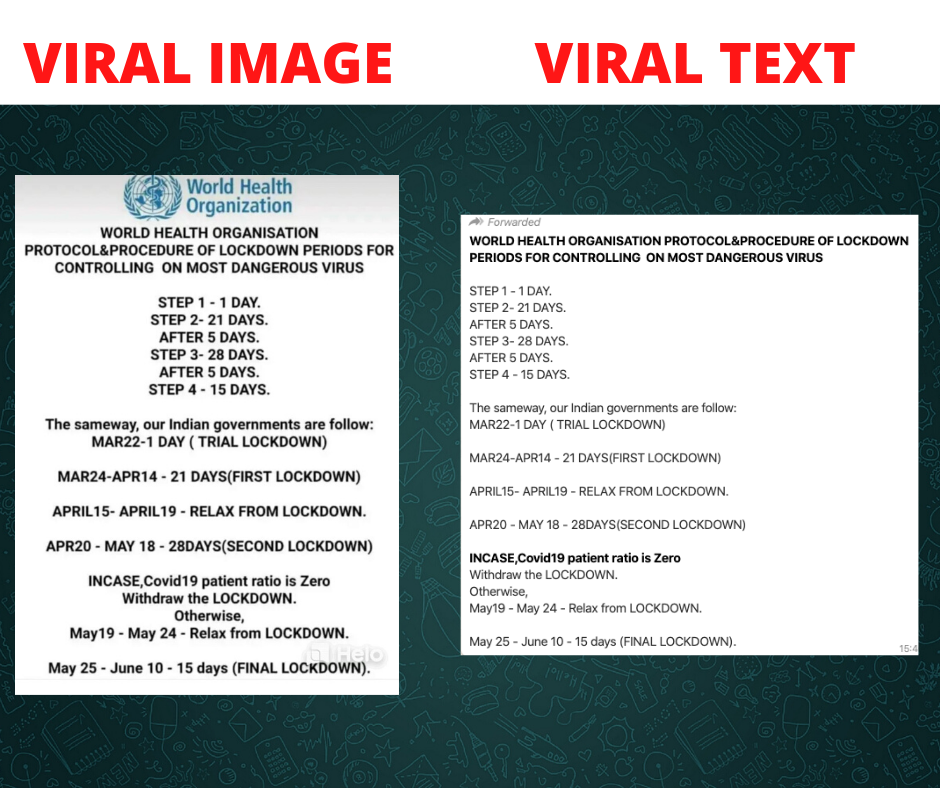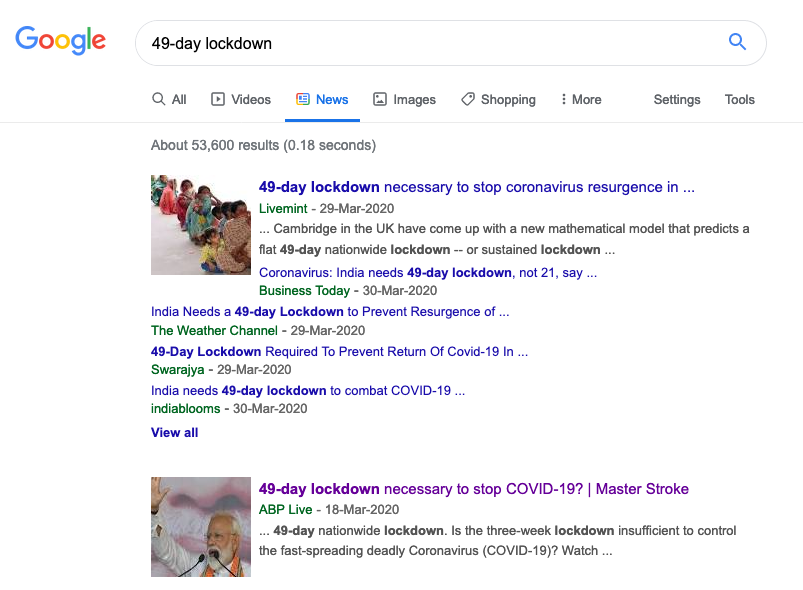A WhatsApp text has gone viral which claims to state the World Health Organisation’s lockdown protocol for controlling dangerous virus outbreaks. The viral message has also been shared in the form of what looks like a circular by WHO. The image carries a stamp of the international body.

The message states that the lockdown protocol should be as follows – one-day ban followed by a 21-day ban, then a 28-day ban after a 5-day hiatus, then a 15-day day after another 5-day hiatus. It also points out that the first two steps are similar to the steps taken by the Indian government – Janta curfew on March 22, followed by the ongoing 21-day ban which is to end on April 14. If the viral message is to be believed, the curfew will end for good on June 10.
The complete viral text reads, “WORLD HEALTH ORGANISATION PROTOCOL&PROCEDURE OF LOCKDOWN PERIODS FOR CONTROLLING ON MOST DANGEROUS VIRUS STEP 1 – 1 DAY. STEP 2- 21 DAYS. AFTER 5 DAYS. STEP 3- 28 DAYS. AFTER 5 DAYS. STEP 4 – 15 DAYS. The sameway, our Indian governments are follow: MAR 22-1 DAY ( TRIAL LOCKDOWN) MAR24-APR14 – 21 DAYS(FIRST LOCKDOWN) APRIL15- APRIL19 – RELAX FROM LOCKDOWN. APR20 – MAY 18 – 28 DAYS(SECOND LOCKDOWN) INCASE,Covid19 patient ratio is Zero Withdraw the LOCKDOWN. Otherwise, May19 – May 24 – Relax from LOCKDOWN. May 25 – June 10 – 15 days (FINAL LOCKDOWN)”.
Alt News has received several requests to fact-check the viral text on WhatsApp (+91 76000 11160) and on our official Android application.

WHO refutes WhatsApp texts
First and foremost, the poor English used in the viral message – grammatical errors and haphazard sentence formations – itself hints that it hasn’t been issued by the WHO. On April 5, WHO South-East Asia posted a tweet debunking such forwards.
Messages being circulated on social media as WHO protocol for lockdown are baseless and FAKE.
WHO does NOT have any protocols for lockdowns. @MoHFW_INDIA @PIB_India @UNinIndia— WHO South-East Asia (@WHOSEARO) April 5, 2020
Secondly, it seems like the viral message is based on media reports and a study published by students at Cambridge University, UK.
An ABP report from April 3 states, “Two Indian-origin researchers from the University of Cambridge in the UK have come up with a model that predicts a flat 49-day nationwide lockdown.” Since then, several media outlets have carried reports which question if three-week lockdown is sufficient or not.

Research paper
Rajesh Singh and R. Adhikari of the Centre for Mathematical Sciences, University of Cambridge published the research paper ‘Age-structured impact of social distancing on the COVID-19 epidemic in India’.
The research presented a mathematical model of the spread of infection in a population structured by age and social contact between ages. The study found that a three-week lockdown is insufficient to prevent a resurgence and, instead, suggested protocols for lockdown with periodic relaxation. One of them forecasts a three-fold lockdown – 21-day, 28-day and 18-day, just like in the viral message.

Therefore the social media claim associated with the WhatsApp text is false. The World Health Organisation has not issued any such ‘lockdown protocol’.
Note: The number of positive cases of the novel coronavirus in India exceeds 5,000 and more than 150 deaths have so far been reported. The government has imposed a complete restriction on movement apart from essential services to tackle the pandemic. Globally, more than 14 lakh confirmed cases and over 80,000 deaths have been reported. There is a sense of panic among citizens, causing them to fall for a variety of online misinformation – misleading images and videos rousing fear or medical misinformation promoting pseudoscience and invalid treatments. While your intentions may be pure, misinformation, spread especially during a pandemic, can take lives. We request our readers to practice caution and not forward unverified messages on WhatsApp and other social media platforms.
[Update: Rajesh Singh and R. Adhikari were referred to as students at Cambridge University. Singh is a post-doctoral researcher while Adhikari is an assistant professor at the University. The same has been rectified.]
Independent journalism that speaks truth to power and is free of corporate and political control is possible only when people start contributing towards the same. Please consider donating towards this endeavour to fight fake news and misinformation.




